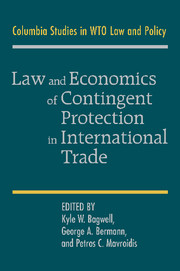Book contents
- Frontmatter
- Contents
- Contributors
- Introduction
- 1 An Overview of the Agreement on Subsidies and Countervailing Measures – Including a Discussion of the Agreement on Agriculture
- 2 Do the World Trade Organization Disciplines on Domestic Subsidies Make Sense? The Case for Legalizing Some Subsidies
- 3 Subsidies and Countervailing Measures: Determining the Benefit of Subsidies
- 4 The Enduring Problem of World Trade Organization Export Subsidies Rules
- 5 The Boeing–Airbus Dispute: A Case for the Application of the European Community State Aid Rules?
- 6 Antidumping: Overview of the Agreement
- 7 Price Differentiation in Antitrust and Trade Instruments
- 8 Nonpreferential Origin Rules in Antidumping Law and Practice
- 9 The Appellate Body Interpretation of “Sunset Reviews” Provisions of Anti-Dumping and Countervailing Measures Agreements: A Critical Analysis
- 10 The Safeguards Agreement – An Overview
- 11 Why Are Safeguards Needed in a Trade Agreement?
- Index
- References
7 - Price Differentiation in Antitrust and Trade Instruments
Published online by Cambridge University Press: 03 May 2010
- Frontmatter
- Contents
- Contributors
- Introduction
- 1 An Overview of the Agreement on Subsidies and Countervailing Measures – Including a Discussion of the Agreement on Agriculture
- 2 Do the World Trade Organization Disciplines on Domestic Subsidies Make Sense? The Case for Legalizing Some Subsidies
- 3 Subsidies and Countervailing Measures: Determining the Benefit of Subsidies
- 4 The Enduring Problem of World Trade Organization Export Subsidies Rules
- 5 The Boeing–Airbus Dispute: A Case for the Application of the European Community State Aid Rules?
- 6 Antidumping: Overview of the Agreement
- 7 Price Differentiation in Antitrust and Trade Instruments
- 8 Nonpreferential Origin Rules in Antidumping Law and Practice
- 9 The Appellate Body Interpretation of “Sunset Reviews” Provisions of Anti-Dumping and Countervailing Measures Agreements: A Critical Analysis
- 10 The Safeguards Agreement – An Overview
- 11 Why Are Safeguards Needed in a Trade Agreement?
- Index
- References
Summary
Introduction
Competition policy overlaps with many forms of government intervention that seek to regulate conduct that falls within the ambit of antitrust statutes. From their origins in the late nineteenth and early twentieth centuries, antitrust and antidumping legal systems have shared an interest in price differentiation – the practice by which a single supplier charges different prices for the same product to distinct classes of customers. Antidumping mechanisms generally forbid a firm from “selling a product in an export market at a price below that which is charged for the same or comparable merchandise in the home market.” Various antitrust commands – for example, prohibitions on predatory pricing – can be interpreted to limit the ability of a firm to use localized price cuts to deter entry or chasten existing rivals.
At times in the twentieth century, both the antitrust and antidumping regimes in the United States treated price differentiation with acute skepticism. In the past three decades, however, U.S. antitrust law has taken a more tolerant view of price differences. Courts and enforcement agencies have embraced analytical approaches for monopolization and attempted monopolization that have given firms progressively greater freedom to choose pricing strategies with the effect of making it more difficult for plaintiffs to sustain claims based on unlawful price differentiation. Since the 1980s, judicial interpretations of the Robinson–Patman (RP) Act have eroded the force of anti–price differentiation provisions that Congress enacted in 1936 with the express purpose of protecting smaller enterprises from the efforts of larger rivals to prevail by extracting special discounts and other concessions from their suppliers.
- Type
- Chapter
- Information
- Publisher: Cambridge University PressPrint publication year: 2009
References
- 1
- Cited by



